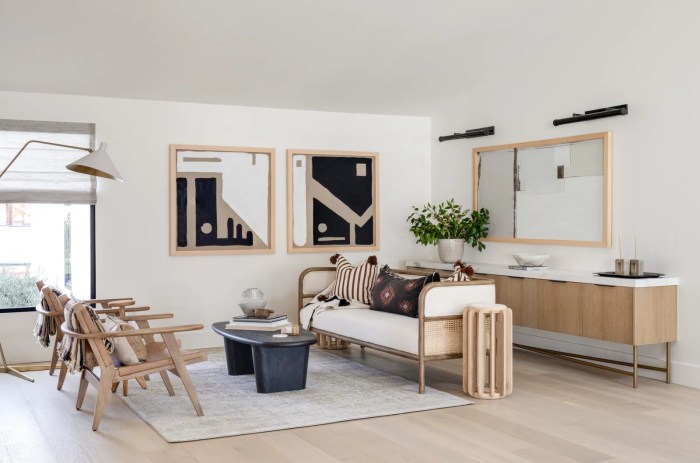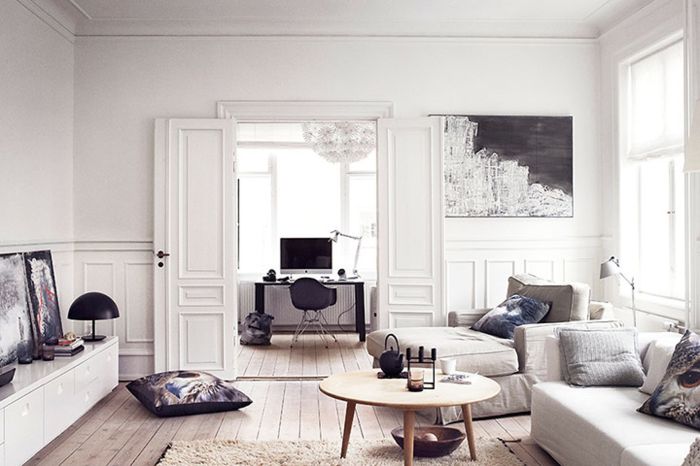Exploring Scandinavian Interior Design: A Modern Approach to Minimalism
Dive into the world of Scandinavian interior design, where simplicity meets functionality and nature blends seamlessly with modern aesthetics. From the clean lines to the cozy textures, this design style offers a refreshing take on home decor that is both timeless and chic.
Unravel the essence of Scandinavian interior design through its key characteristics, color palettes, furniture elements, lighting techniques, textures, and materials that make it a popular choice for many homeowners seeking a balance between style and comfort.
Introduction to Scandinavian Interior Design
Scandinavian interior design is a minimalist, functional, and cozy style that originated in the Nordic countries of Denmark, Norway, Sweden, and Finland. It is known for its simplicity, clean lines, and emphasis on natural materials.
Key Characteristics of Scandinavian Interior Design
- Neutral color palettes: White, grey, and beige tones dominate the color scheme, creating a sense of calm and serenity.
- Minimalist furniture: Functional pieces with clean lines and simple designs are favored, often with a focus on functionality and comfort.
- Natural elements: Wood, stone, and plants are incorporated to bring a sense of nature indoors, adding warmth and texture to the space.
- Lighting: Natural light is maximized through large windows and light curtains, with the use of soft, ambient lighting to create a cozy atmosphere.
History and Origins of Scandinavian Interior Design
Scandinavian interior design emerged in the early 20th century as a response to the harsh winters and limited daylight in the region. The design philosophy focused on creating bright, airy spaces that were functional yet inviting, with an emphasis on quality craftsmanship and sustainability.
Color Palette in Scandinavian Interior Design

In Scandinavian interior design, the typical color palette revolves around neutral tones, such as whites, greys, and beiges. These colors are chosen to create a sense of light, airy, and spacious atmosphere in the interiors.
Light vs. Dark Colors in Scandinavian Interiors
Light colors are predominantly used in Scandinavian interiors to enhance natural light and create a sense of openness. Whites and soft pastels are often used on walls, while light wood tones are common for furniture and flooring. Dark colors, on the other hand, are sparingly used to create contrast and add depth to the space.
Deep blues, greens, or blacks may be incorporated through accents like pillows, rugs, or artwork.
Color Influence on Aesthetic
- White: White is a staple color in Scandinavian design, symbolizing purity, simplicity, and minimalism. It helps reflect light and creates a clean, uncluttered look.
- Greys and Beiges: These neutral tones add warmth and sophistication to the space, allowing other elements like textures and materials to stand out.
- Pops of Color: Scandinavian interiors often incorporate pops of color through accessories like cushions, rugs, or artwork. These accents add personality and playfulness to the otherwise muted color scheme.
Furniture and Decor Elements

Scandinavian interior design is known for its emphasis on simplicity, minimalism, and functionality. When it comes to furniture and decor elements, these principles are reflected in the choice of pieces and how they are incorporated into the overall design.
Common Furniture Pieces
In Scandinavian interiors, you will often find furniture pieces that are sleek, modern, and timeless. Some common items include:
- Mid-century modern sofas and chairs with clean lines
- Wooden dining tables and chairs
- Storage units with simple designs
- Light fixtures made of metal or wood
Importance of Minimalism and Functionality
Scandinavian furniture design prioritizes minimalism and functionality. Every piece serves a purpose while maintaining a clean and uncluttered look. The focus is on quality craftsmanship and practicality, rather than ornate details or excessive decorations. This approach not only creates a sense of calm and tranquility in the space but also ensures that each item is both beautiful and useful.
Natural Elements in Decor
Natural elements play a significant role in Scandinavian decor, bringing a sense of warmth and connection to the outdoors. Wood is a predominant material used for furniture, flooring, and accents, adding a cozy and inviting feel to the space. Greenery in the form of plants and botanical prints is also commonly integrated to bring life and freshness into the interior.
These natural elements contribute to the overall sense of harmony and balance in Scandinavian design.
Lighting in Scandinavian Interior Design
Lighting plays a crucial role in creating a cozy and inviting atmosphere in Scandinavian interiors. The right lighting fixtures can enhance the overall aesthetic and functionality of a space, while maximizing natural light can help create a bright and airy feel.
Types of Lighting Fixtures
- Pendant Lights: These are commonly used in Scandinavian interiors to provide focused task lighting while adding a touch of style.
- Table Lamps: Table lamps are versatile and can be used to create ambient lighting in living rooms, bedrooms, or home offices.
- Wall Sconces: Wall sconces are great for adding a warm glow to hallways, entryways, or accentuating specific areas of a room.
- Floor Lamps: Floor lamps are practical for providing additional lighting in reading nooks or dark corners of a room.
Maximizing Natural Light
One of the key principles of Scandinavian design is to maximize natural light in a space. Here are some tips to achieve this:
- Use sheer curtains or blinds to allow natural light to filter through while maintaining privacy.
- Position furniture away from windows to avoid blocking natural light from entering the room.
- Opt for light-colored walls and furniture to reflect natural light and create a bright and airy feel.
- Consider adding mirrors to walls opposite windows to help bounce natural light around the room.
Textures and Materials

In Scandinavian interior design, textures and materials play a crucial role in creating a cozy and inviting atmosphere. The use of natural elements such as wool, linen, and fur adds warmth and tactile appeal to the space, enhancing the overall aesthetic.
Types of Textures and Materials
- Wool: Wool is a staple material in Scandinavian interiors due to its softness and warmth. It is commonly used in rugs, blankets, and upholstery to add texture and comfort to the room.
- Linen: Linen is another popular fabric choice in Scandinavian design. Its light and airy texture bring a sense of freshness and lightness to the space, making it ideal for curtains, bedding, and table linens.
- Fur: Faux fur or sheepskin rugs are often used in Scandinavian interiors to create a cozy and luxurious feel. They add a touch of softness and elegance, especially when layered over furniture or floors.
Mixing Textures for Depth and Warmth
By combining different textures and materials, you can add depth and visual interest to a Scandinavian-inspired space. For example, pairing a wool rug with linen curtains and a fur throw blanket can create a layered look that is both inviting and stylish.
Mixing rough textures like wool with smoother materials like leather or wood can also create a balanced and harmonious feel in the room.
Creating a Scandinavian Inspired Space
When it comes to creating a Scandinavian inspired space, there are a few key elements to keep in mind to achieve that minimalist and cozy look.
Incorporating Scandinavian Design Elements
To bring Scandinavian design into a room, focus on clean lines, natural materials, and a neutral color palette. Opt for furniture with simple, functional designs and add in elements of nature like plants or wooden accents. Textiles such as wool blankets and sheepskin rugs can also add warmth to the space.
Importance of Decluttering and Organization
Decluttering and organization are essential in achieving a Scandinavian look. Keep surfaces clean and free of unnecessary items to create a sense of calm and simplicity. Utilize storage solutions like baskets or shelves to keep things tidy and organized.
DIY Projects and Affordable Ideas
- Painting furniture in light, neutral colors or pastel tones can instantly give it a Scandinavian feel.
- Adding in some DIY wooden shelves or plant hangers can bring a touch of Scandinavian charm to the space.
- Thrift shopping for second-hand items like vases, frames, or textiles can be a budget-friendly way to incorporate Scandinavian style into your home.
Concluding Remarks
In conclusion, Scandinavian interior design captures the essence of modern simplicity and natural beauty, creating spaces that are both inviting and stylish. Embrace the Nordic charm in your own home by incorporating these design principles to elevate your living environment.
FAQ Compilation
What sets Scandinavian interior design apart from other styles?
Scandinavian design focuses on minimalism, functionality, and a strong connection to nature, creating spaces that are both practical and visually appealing.
How can I incorporate Scandinavian design elements into my home?
You can start by decluttering your space, adding natural elements like wood and greenery, opting for light color palettes, and choosing furniture with clean lines and simple designs.
What role does lighting play in Scandinavian interiors?
Lighting is crucial in creating a cozy atmosphere in Scandinavian design, with an emphasis on natural light and the use of various lighting fixtures to enhance the overall ambiance.




